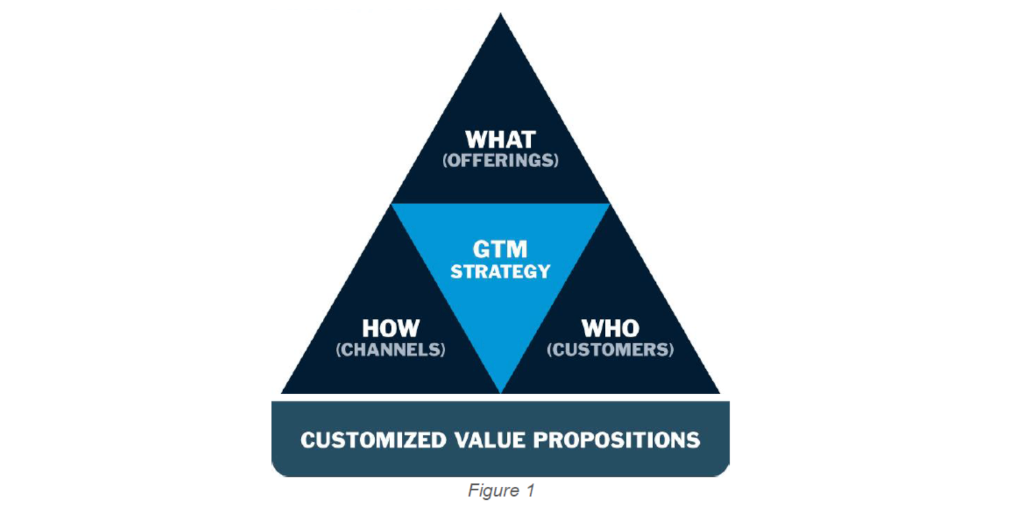
A go-to-market (GTM) strategy is the way in which a company brings a product or service to market.
No matter how good your idea is, you need a go-to-market strategy.
Why?
Because statistically speaking, your business is more likely to fail than succeed.
In fact, if you’re a startup, your chance of failure is a dreary 90%. That’s not to say that your idea isn’t a brilliant one, or that you haven’t got what it takes to bring it to market.
Startups fail for different reasons. Perhaps the market is already awash with companies offering the same solution as yours, or the market isn’t mature enough to welcome your product. Or, maybe the cost of developing and launching your product is so steep that it’s unprofitable.
If successful, a go-to-market strategy will be your salvation and prevent you from failure. The question is, how do you develop a winning strategy? Which factors should you consider?
I asked our VP of Marketing Bryan Sise these very questions. Through the course of his career at companies like Twilio, SendGrid, Twitter, Dynamic Signal, and now Process Street, Bryan has noticed what contributes to GTM success.
In this post I’ll share with you what he has to say. I’ll cover what a go-to-market strategy is, types of go-to-market strategies, the key steps to building a successful go-to-market strategy, and what GTM strategies we use here at Process Street.
- What is a go-to-market strategy?
- 6 factors to consider when building a go-to-market strategy
- Types of go-to-market strategies
- Key steps to building a successful go-to-market strategy
- Go-to-market strategies at Process Street
What is a go-to-market strategy?
“A go-to-market strategy generally includes a business plan that outlines how Marketing, Sales, Customer Success, Product Engineering, and product teams intend to work together to ensure growth and measure the success of your product. Typically, a GTM strategy asks a handful of questions; these questions are then answered differently depending on the growth tactic your business is implementing.” – Molly Stovold, Build a Product That Sells Itself With Product-Led Growth
To learn more about growth tactics check out how Ryan Hoover, Founder of Product Hunt, acquired over 2000 users by doing things that didn’t scale. Listen to this episode of our podcast Tech Out Loud.
Tech Out Loud is the only podcast that brings you the most impactful blog posts from the biggest names in tech, straight to your ears. You can also listen to this podcast on other platforms. Click to see the full list! If you enjoyed this podcast, subscribe for a new episode each week.
Ultimately, the questions asked within a GTM strategy serve to deepen your understanding of your industry and target market so you can develop a product-market fit. In asking these questions, you begin to rid your strategy of any assumptions you may have made when beginning the project.
In case you’re thinking there’s no way the market won’t love your flawless idea, I’m sorry to say that everyone – you, me, your boss Barry – makes assumptions with product launches.
Why?
Because your product is your brainchild, it’s an idea that you want to work. Naturally, you want to get it out there ASAP, and, because you love it so much, you assume the market will too. So, you cut corners when researching, make assumptions on your pricing, and rush your development process.
The problem is, each and every one of these actions is likely to backfire, leaving you to join the mass of other failed startups. Skimping on your strategy is simply not worth it.
So, if a go-to-market strategy is so important, how do you begin to develop one? For starters it’s important to consider the following 6 factors:
6 factors to consider when building a go-to-market strategy
1. Clear value message and a compelling call to action
It all boils down to what’s in it for the customer. Consider the following questions:
- Why should they bother to take a few moments to read and consider your message?
- How can you concisely describe how you can solve a problem they have?
- How can you make clear to them what you’re asking them to do, in a way that will feel like a lightweight next step to them, instead of an onerous commitment?
- And finally, how can you explain why it makes sense for them to take that next step now, instead of sometime in the future?
2. Internal alignment and lead time
Go-to-market strategies are strongest when there is clear agreement across functional teams and leadership that the GTM initiative is important. Teams and leadership should be in agreement about:
- Why the go-to-market strategy is important;
- Determining the goals;
- Considering how each goal attainment will be measured;
- Ensuring accountability across the team for each part of the GTM strategy.
It’s also important that involved teams are given reasonable lead time to be able to form the go-to-market strategy and do the work to bring it to life. This requires that the GTM strategy is broken down into component parts, with realistic estimates made for the time required to complete each part — with the estimates made by the people who will be doing the work.
3. Operational coordination around the customer experience
Even when a GTM initiative (like a new marketing campaign) has targeted outreach, attractive branding, and an effective message, it can still fail; particularly if a person’s experience “after the click” is poor.
When forming a go-to-market strategy, it’s a must to gain cross-functional commitments regarding what will happen once a person expresses interest. For example, if they need to fill out a form in order to sign up, consider the following:
- What will their experience of that form be?
- When their information is submitted after form completion, how will their information be routed to internal teams, and who will own the follow-up?
- If they will receive a physical product or a service, what logistical obstacles will need to be navigated?
- What exactly will be done from an operational perspective in order to quickly fulfill the promise that the new marketing campaign made to that person?
4. Anticipate what might come up and what might go sideways
When you go live with a new GTM initiative, like a product launch or an exciting announcement, people are going to have questions, and they may also have concerns. Be sure to prepare yourself for questions or doubts concerning:
- Prospects might ask whether they’re eligible to receive what you’re offering.
- If they’re a current customer, they might wonder what this new change means for them.
As your GTM strategy begins to form, it’s worthwhile to think deeply on and ask your colleagues about, all the questions or concerns that your new announcement might generate (it can be especially useful to discuss this with people in Customer Support, Customer Success, and Sales). It’s also worth considering how things might go wrong:
- What are the risks of your GTM strategy?
Anticipating what could happen might allow you to, for example, write FAQs to accompany your GTM messaging, to equip your Customer Success team with talking points, or to reconsider your planned message if you realize that it might land the wrong way.
5. Sustained messaging and market presence
Go-to-market strategies tend to be focused on “the big day” — the day of the product launch or the exciting announcement. While certainly, it’s important to make the most of launch day, the GTM strategy should also include plans for the ways that the message will be propagated and elaborated in the days and weeks following the big day.
After all, it often requires some message repetition in order to prompt audience members to act on a message. You have the opportunity to evolve and elaborate on the message in the days and weeks following launch, deepening your audience’s understanding of why your message is important for them.
6. Learning from each GTM initiative to inform future GTM initiatives
The most effective marketing teams view everything as an experiment. If they plan to make a change to some aspect of the company’s market presence, or if they plan to bring something new to the market, they view themselves as conducting an experiment with the intention of learning from its outcome. It’s all for the purpose of continually homing in on what the most effective marketing activities and messages are.
An experimental mindset implies that, while the people involved with the GTM strategy might have an opinion on how effective it will be (and should make projections and set goals accordingly), they are essentially forming a hypothesis, and taking an objective approach toward validating (or disconfirming) that hypothesis. Even when a GTM strategy doesn’t turn out the way they hypothesized it would, they have a responsibility to share the learnings from the experiment with their colleagues. These findings are vital for a company to advance its institutional knowledge about what works, and what doesn’t.
Types of go-to-market strategies

Along with the six factors listed above, you’ll also want to ensure that you’ve established a product-market fit and have an idea of your ideal buyers before defining your strategy. With these covered you can begin to dive deeper and ask the questions that form the backbone of a well developed GTM strategy:
- What is your ideal customer profile (ICP)?
- Why would your ICP choose your product over a competitor’s?
- What could prevent a prospect from buying your product?
In choosing which go-to-market strategy works best for you, it’s important to remember that each strategy should be unique and dependent on your individual business requirements. It should be tailored to your product, ICP, business, team, and so on.
Nevertheless, there are three growth strategies that provide a broad idea of how to approach your target market. These three strategies: dominant, differentiated, and disruptive, work best in the SaaS/tech area. There are, however, heaps of other strategies out there, check out: The Jobs-to-be-Done Growth Strategy Matrix by Tony Ulwick (founder of Strategyn).
*Pro-tip: I wrote about how each of these three GTM strategies can be used when taking a product-led approach in a recent article: Build a Product That Sells Itself With Product-Led Growth.
Dominant:
Simply put, the dominant growth strategy works best if you dominate the market by having the best product and can charge significantly less than your competitors. Questions to ask yourself when deciding if a dominant growth strategy is right for you:
- Does your product solve a specific job significantly better and at a lower cost than anyone else in the market?
- Can your user realize significant ongoing value quickly with little-to-no help from company personnel?
- Do you want to be the undisputed market leader in your category?
- Is your TAM big enough to support the dominant model?
Differentiated:
Be different. Differentiated growth involves finding an underserved niche product within a market that is better than the competition and then charging significantly more. Questions to ask yourself when deciding if a differentiated growth strategy is right for you:
- Is your market composed of underserved customers?
- What is your TAM?
- Is your Annual Contract Value (ACV) high enough to support a low- or high-touch Sales team?
Disruptive:
Is your product a scaled-down version of an existing solution? If so then it’s time to be disruptive. The disruptive growth approach requires you to charge less for what may be considered an “inferior product”. Questions to ask yourself when deciding if a disruptive growth strategy is right for you:
- Is your market full of over-served customers? Are you competing in a red ocean?
- Is your market large enough to support a disruptive approach? (Hint: Look to your competitors to gauge the market size.)
- Do you have the resources to support a disruptive approach?
- Can your user onboarding be completely self-service?
As I said, these are just a few of the more popular growth strategies within the SaaS arena. Later in this post, I’ll highlight the approach that we at Process Street take for developing GTM strategies.
For those of you who are new to Process Street and wish to learn more about what we do before I take a deep dive into our marketing strategy, check out this explainer video. But first, let’s take a look at the key steps to consider when building a successful go-to-market strategy.
Key steps to building a successful go-to-market strategy
Now you have some examples of GTM strategies, and know which factors to consider. Let’s take a look at the key steps to take within the process itself. If you’re wondering where to start, and are hoping to spearhead a GTM strategy then this section is for you.
Learn about the new thing
The “new thing” is the reason the GTM strategy is being formed in the first place — it might be a new product, a new service offering, or a new company accomplishment. If it’s a new product, for example, sit down with the people who built the product and learn about what it was built to do and how it works. Touch and feel the product first-hand, to understand the product’s strengths and limitations, and to envision what the customer experience of that product will be.
Identify the core message
Consider who “the new thing” is for. Who are they and what is their worldview? What problems or needs do they have that might make the new thing relevant for them? What are they likely to be doing and thinking when they first see news of the new thing?
Then start writing down ideas of how the new thing could be messaged to the audience. And start bouncing those ideas off of anyone you can talk to — that can be people internal to your company (especially people who talk to customers every day), but it’s best if it’s customers and target audience members themselves. Use the feedback to make an informed decision on what your core message about the new thing should be.
Form your launch team
Assemble a group of people across several functions, frequently including people from Marketing, Customer Success, Customer Support, Sales, Operations, etc. Meet frequently with your launch team in the weeks leading up to go-live. These are the people who will think through key GTM strategy considerations with you, who will own selected parts of the work required to execute on the GTM strategy, and who will represent the point of view of their respective functionals on important go-to-market decisions.
According to Bryan, some of the most rewarding moments have been working with a cross-functional launch team. A cross-functional team has the advantage of sharing diverse perspectives on the GTM strategy and working together to bring the message to life on launch day.
“Here at Process Street, I know we’ll be driving several exciting new GTM strategies in the months and years to come, because of the ways we are rapidly evolving our workflow software platform to power team processes in thousands of companies globally.” – Bryan Sise, VP of Marketing at Process Street
In many ways, these three steps and the way in which they should be carried out (through asking questions) are similar to the three go-to-market strategies I referenced earlier (dominant, differentiated, disruptive). In the questions concerning each of the approaches you are encouraged to cover these steps, particularly the first “learn about the new thing”.
Now, as promised, I’ll take you through how we approach go-to-market strategies at Process Street…
Go-to-market strategies at Process Street

“The best feeling is when your message hits the mark, and it connects customers to something they really value.” – Bryan Sise, VP of Marketing at Process Street
At Process Street, we choose GTM strategies that are measurable. We take a test-and-learn approach to introduce new marketing programs and messaging, and we identify objectives and key results that help us focus our efforts and evaluate our performance.
We focus mainly on the downstream business impact of our activities. Why? Because we know that engagement metrics like clicks and visits are less important than metrics like customer acquisition, customer retention, and revenue growth.
Here at Process Street, we believe in the power of great content to build relationships with our target audience. We continually create and share content that fits with their career interests and our brand identity, which is all about making recurring work fun, fast and faultless.
When it comes to connecting with our audience we try to meet them where they are in terms of their level of purchase intent. If they’re at a point where they recognize their team’s need for workflow management software, we take an educational approach, showing them how Process Street fits with their most important use cases, such as an HR team’s employee onboarding process or an IT team’s security audit process. In collaboration with the Sales, Customer Success, and Support teams at Process Street, we craft content that shows our customers how we’re invested in their success.
Rather than only managing one-off projects and initiatives, we continually run marketing processes that are repeatable and optimizable — such as blogging, podcasting, or running LinkedIn ad campaigns. This helps us to be more efficient in our work and creates a flywheel of growth that we can keep optimizing and accelerating. We use tools like Process Street (funnily enough ), Airtable, and Zapier, which help us coordinate our efforts, consistently follow key process steps, and automate wherever possible.
In addition to these ongoing processes, we punctuate our presence in the market with key announcements, such as when we recently launched Process Street 3.0. While we feel it’s important to create excitement on the day of an announcement, we try to avoid “flash in the pan” marketing. Instead, we continue to work to further propagate the announcement message in the days and weeks after the launch.
Like any startup, we have resource constraints, so we actively prioritize the marketing programs and projects that we believe are most likely to help grow our business. One of the exciting things about working in a startup environment is that a single change — to our website, to an ad campaign, to a lifecycle email — can have a significant impact on our overall performance.
Our team has no shortage of ideas and opinions on the changes we could make or new initiatives we could undertake.
As we make tough prioritization decisions, we ask ourselves:
- What will the audience reach be?
- What do we expect will be the impact on our key business metrics?
- How confident are we in that projection of positive business impact?
- What level of effort will be required to execute the project? (These factors — Reach, Impact, Confidence, and Effort — are together known as RICE scoring, a useful prioritization approach conceived by the folks at Intercom.)
Wrapping up
There we have it. Hopefully, this post will help you avoid the dark abyss of startup failure and succeed to unicorn status.
I’ll wrap things up with a final quote from Bryan:
“A unified go-to-market strategy (…) should consider all the ways your audience could encounter and experience your company and its products. (…) So it’s important to consider the entire customer experience of your go-to-market motion, and to collaborate cross-functionally in order to make that experience the best it can be.”
We’d love to hear about the different go-to-market approaches you use in the comments. Who knows? You may even get featured in an upcoming article!









Molly Stovold
Hey, I'm Molly, Junior Content Writer at Process Street with a First-Class Honors Degree in Development Studies & Spanish. I love writing so much that I also have my own blog where I write about everything that interests me; from traveling solo to mindful living. Check it out at mollystovold.com.